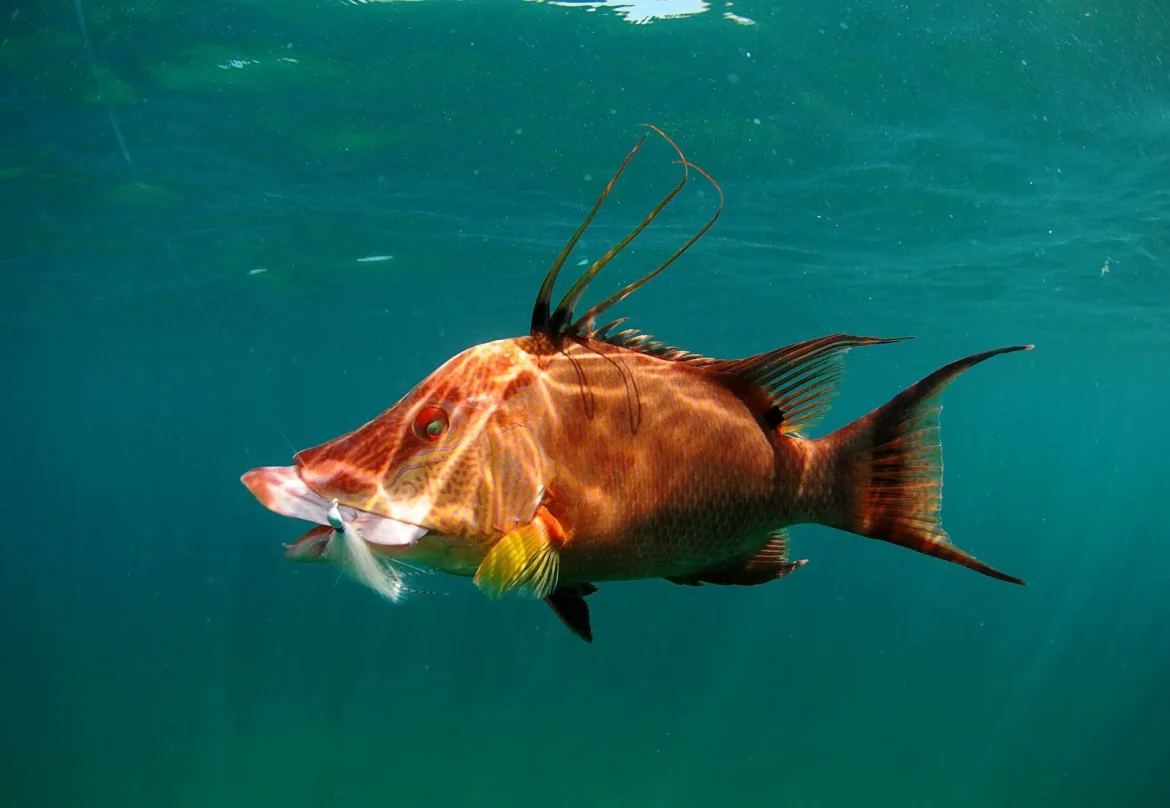Researchers now believe they have uncovered the reason behind an intriguing phenomenon. Several years ago, biologist Lori Schweikert had a remarkable encounter during a fishing trip in the Florida Keys. While handling a hogfish, a reef fish with a distinctive snout, she noticed something peculiar. Placing the fish on her boat’s deck and later intending to move it to a cooler, she was astonished to find that the fish’s skin had adopted the exact color and pattern of the boat’s deck.
The hogfish, commonly found in the western Atlantic Ocean from North Carolina to Brazil, is renowned for its remarkable ability to change the color of its skin rapidly. It can transition from white to mottled to reddish-brown almost instantly, adapting to blend seamlessly with its surroundings, such as corals, sand, or rocks.
What surprised Schweikert was that this color adaptation had persisted even though the hogfish was no longer alive. This curiosity led her to investigate whether hogfish could perceive light through their skin, independently of their eyes and brain. “This discovery opened up an entirely new avenue of exploration for me,” Schweikert remarked.
In the subsequent years, Schweikert embarked on a journey to delve into the concept of “skin vision.” As a postdoctoral fellow at Duke University and Florida International University, she conducted research into the physiology of this intriguing phenomenon. In 2018, Schweikert and Duke biologist Sönke Johnsen unveiled their findings through a study. They revealed that hogfish possess a gene responsible for a light-sensitive protein called opsin, which is activated within their skin. Importantly, this gene differs from the opsin genes present in their eyes.

Various creatures, including octopuses and geckos, have been found to possess light-sensing opsins in their skin, much like hogfish. Nevertheless, the precise manner in which these animals employ these opsins for color-changing purposes remains a puzzle.
Lori Schweikert, currently an assistant professor at the University of North Carolina Wilmington, expressed her astonishment when they discovered light detectors in hogfish skin. She posed the question of why such animals would have light detectors in their skin to her colleague, Sönke Johnsen.
The role of opsin proteins and evolutionary insights
One theory is that light-sensitive skin aids animals in perceiving their environment. However, a novel notion has emerged—these creatures might be using this ability to observe themselves. Schweikert, along with Johnsen and a team of researchers, conducted an in-depth exploration of hogfish skin in a study recently published in Nature Communications.
Using skin samples from various parts of the hogfish’s body, the researchers examined the skin under a microscope. Close-up views revealed a skin pattern resembling a pointillist painting, with each colored dot representing a specialized cell called a chromatophore. These cells contain pigment granules of red, yellow, or black, and the movement of these granules governs the change in skin color. Spreading out leads to a darker color, while clustering creates transparency.
Through immunolabeling, the team identified the presence of opsin proteins in the skin. Interestingly, these opsins were not produced within the color-changing chromatophores but rather in cells just beneath them. Further examination with a transmission electron microscope unveiled a previously unknown cell type beneath the chromatophores, densely packed with opsin protein. This positioning indicates that light must traverse the pigment-filled chromatophores before reaching the light-sensitive layer beneath.

Higher adaptability to the color blue
The researchers determined that the opsin molecules in hogfish skin are most attuned to blue light, which coincidentally matches the wavelength absorbed best by the pigment granules in the chromatophores. This suggests that the light-sensitive opsins act as an internal mechanism, capturing alterations in light as it filters through the pigment-filled cells while the granules rearrange.
In a metaphorical sense, these opsins work akin to internal Polaroid film, allowing the animals to effectively ‘photograph’ their own skin from within. This self-monitoring mechanism assists hogfish in adjusting their coloration according to their visual perception.
Schweikert emphasizes that hogfish skin isn’t functioning like an eye; it lacks the capability to form images as eyes do. Instead, it operates as a sensory feedback mechanism, enabling the fish to observe its own color shifts and align them with its visual input.
Can we see with our skin?
While we may not be able to see through our skin, robots and self-driving cars one day will. Because the importance of this research extends to potential applications in technology. The concept of sensory feedback, crucial for tasks like refining the performance of robotic limbs and self-driving cars, remains a challenge. This study’s insights offer an innovative approach to this challenge.
Schweikert underscores the importance of such sensory feedback for creatures reliant on color-changing abilities for survival. In scenarios where these abilities are used to hide from predators, communicate with rivals, or attract mates, the ability to self-monitor color changes can indeed be a matter of life and death.
References: Schweikert LE, Bagge LE, Naughton LF, Bolin JR, Wheeler BR, Grace MS, Bracken-Grissom HD, Johnsen S. Dynamic light filtering over dermal opsin as a sensory feedback system in fish color change - Nature Communications. Nature. 2023. Available from: https://www.nature.com/articles/s41467-023-40166-4
https://scitechdaily.com/beyond-eyes-this-fish-can-see-with-its-skin/?expand_article=1


Leave a Reply